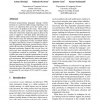Free Online Productivity Tools
i2Speak
i2Symbol
i2OCR
iTex2Img
iWeb2Print
iWeb2Shot
i2Type
iPdf2Split
iPdf2Merge
i2Bopomofo
i2Arabic
i2Style
i2Image
i2PDF
iLatex2Rtf
Sci2ools
POS
1998
Springer
1998
Springer
Optimizing the Read and Write Barriers for Orthogonal Persistence
Persistent programming languages manage volatile memory as a cache for stable storage, imposing a read barrier on operations that access the cache, and a write barrier on updates to the cache. The read barrier checks the cache residency of the target object while the write barrier marks the target as dirty in the cache to support a write-back policy that defers updates to stable storage until eviction or stabilization. These barriers may also subsume additional functionality, such as negotiation of locks on shared objects to support concurrency control. Compilers for persistent programming languages generate barrier code to protect all accesses to possibly persistent objects. Orthogonal persistence imposes this cost on every object access, since all objects are potentially persistent, at significant overhead to execution. We have designed a new suite of compiler optimizations, focusing on partial redundancy elimination of pointer-based access expressions, that significantly reduce thi...
Persistent Programming Languages | POS 1998 | Programming Languages | Read Barrier | Write Barriers |
| Added | 06 Aug 2010 |
| Updated | 06 Aug 2010 |
| Type | Conference |
| Year | 1998 |
| Where | POS |
| Authors | Antony L. Hosking, Nathaniel Nystrom, Quintin I. Cutts, Kumar Brahnmath |
Comments (0)

